CHCAGE001 Facilitate Empowerment of Older People Learner Workbook
VerifiedAdded on 2023/06/18
|22
|5961
|416
Homework Assignment
AI Summary
This document presents a comprehensive solution to the CHCAGE001 Learner Workbook, focusing on facilitating the empowerment of older people. It covers key aspects such as conducting interpersonal exchanges to build trust, respecting social and cultural differences, maintaining confidentiality, and identifying strategies to promote healthy lifestyles. The solutions address various activities, including understanding legal and ethical considerations, identifying enablers and disablers impacting health outcomes, encouraging shared responsibility for self-support, and adjusting services to meet individual needs. Furthermore, it delves into assisting older individuals in understanding their rights, recognizing and reporting abuse, and accessing support services and complaint mechanisms, providing a thorough guide to effectively supporting and empowering older people within the aged care context.
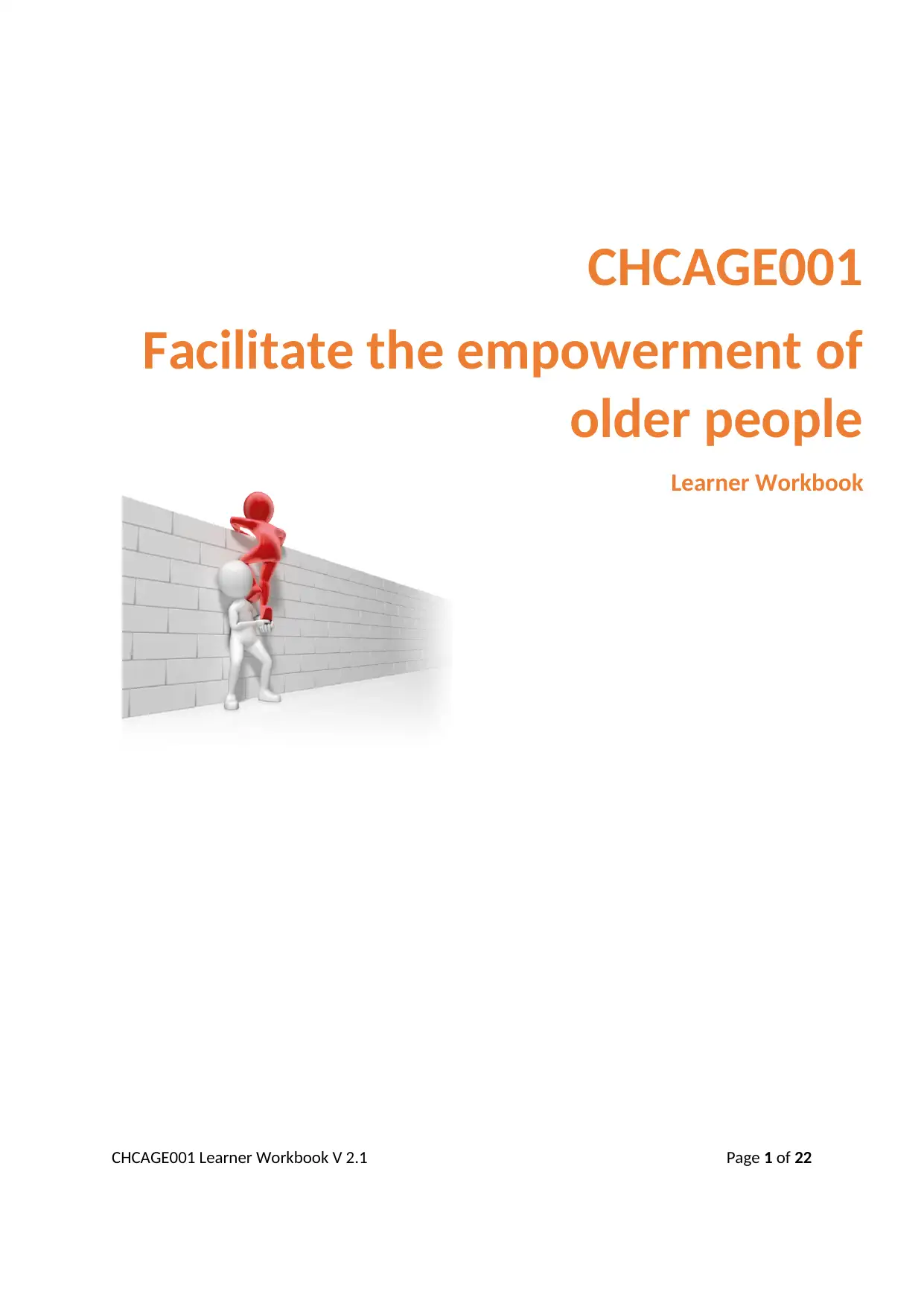
CHCAGE001 Learner Workbook V 2.1 Page 1 of 22
CHCAGE001
Facilitate the empowerment of
older people
Learner Workbook
CHCAGE001
Facilitate the empowerment of
older people
Learner Workbook
Paraphrase This Document
Need a fresh take? Get an instant paraphrase of this document with our AI Paraphraser
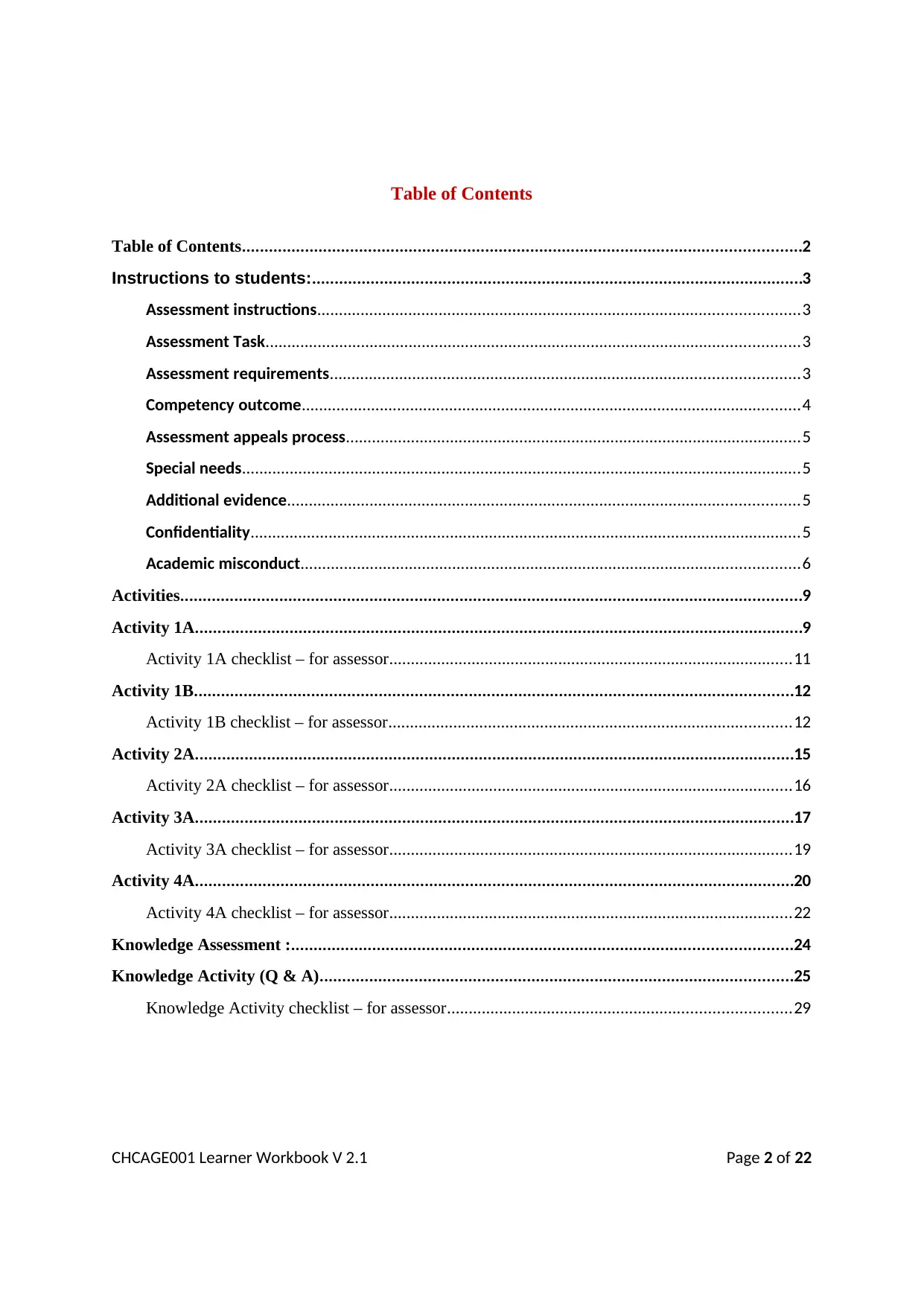
Table of Contents
Table of Contents............................................................................................................................2
Instructions to students:.............................................................................................................3
Assessment instructions...............................................................................................................3
Assessment Task...........................................................................................................................3
Assessment requirements............................................................................................................3
Competency outcome...................................................................................................................4
Assessment appeals process.........................................................................................................5
Special needs.................................................................................................................................5
Additional evidence......................................................................................................................5
Confidentiality...............................................................................................................................5
Academic misconduct...................................................................................................................6
Activities..........................................................................................................................................9
Activity 1A.......................................................................................................................................9
Activity 1A checklist – for assessor.............................................................................................11
Activity 1B.....................................................................................................................................12
Activity 1B checklist – for assessor.............................................................................................12
Activity 2A.....................................................................................................................................15
Activity 2A checklist – for assessor.............................................................................................16
Activity 3A.....................................................................................................................................17
Activity 3A checklist – for assessor.............................................................................................19
Activity 4A.....................................................................................................................................20
Activity 4A checklist – for assessor.............................................................................................22
Knowledge Assessment :...............................................................................................................24
Knowledge Activity (Q & A).........................................................................................................25
Knowledge Activity checklist – for assessor...............................................................................29
CHCAGE001 Learner Workbook V 2.1 Page 2 of 22
Table of Contents............................................................................................................................2
Instructions to students:.............................................................................................................3
Assessment instructions...............................................................................................................3
Assessment Task...........................................................................................................................3
Assessment requirements............................................................................................................3
Competency outcome...................................................................................................................4
Assessment appeals process.........................................................................................................5
Special needs.................................................................................................................................5
Additional evidence......................................................................................................................5
Confidentiality...............................................................................................................................5
Academic misconduct...................................................................................................................6
Activities..........................................................................................................................................9
Activity 1A.......................................................................................................................................9
Activity 1A checklist – for assessor.............................................................................................11
Activity 1B.....................................................................................................................................12
Activity 1B checklist – for assessor.............................................................................................12
Activity 2A.....................................................................................................................................15
Activity 2A checklist – for assessor.............................................................................................16
Activity 3A.....................................................................................................................................17
Activity 3A checklist – for assessor.............................................................................................19
Activity 4A.....................................................................................................................................20
Activity 4A checklist – for assessor.............................................................................................22
Knowledge Assessment :...............................................................................................................24
Knowledge Activity (Q & A).........................................................................................................25
Knowledge Activity checklist – for assessor...............................................................................29
CHCAGE001 Learner Workbook V 2.1 Page 2 of 22
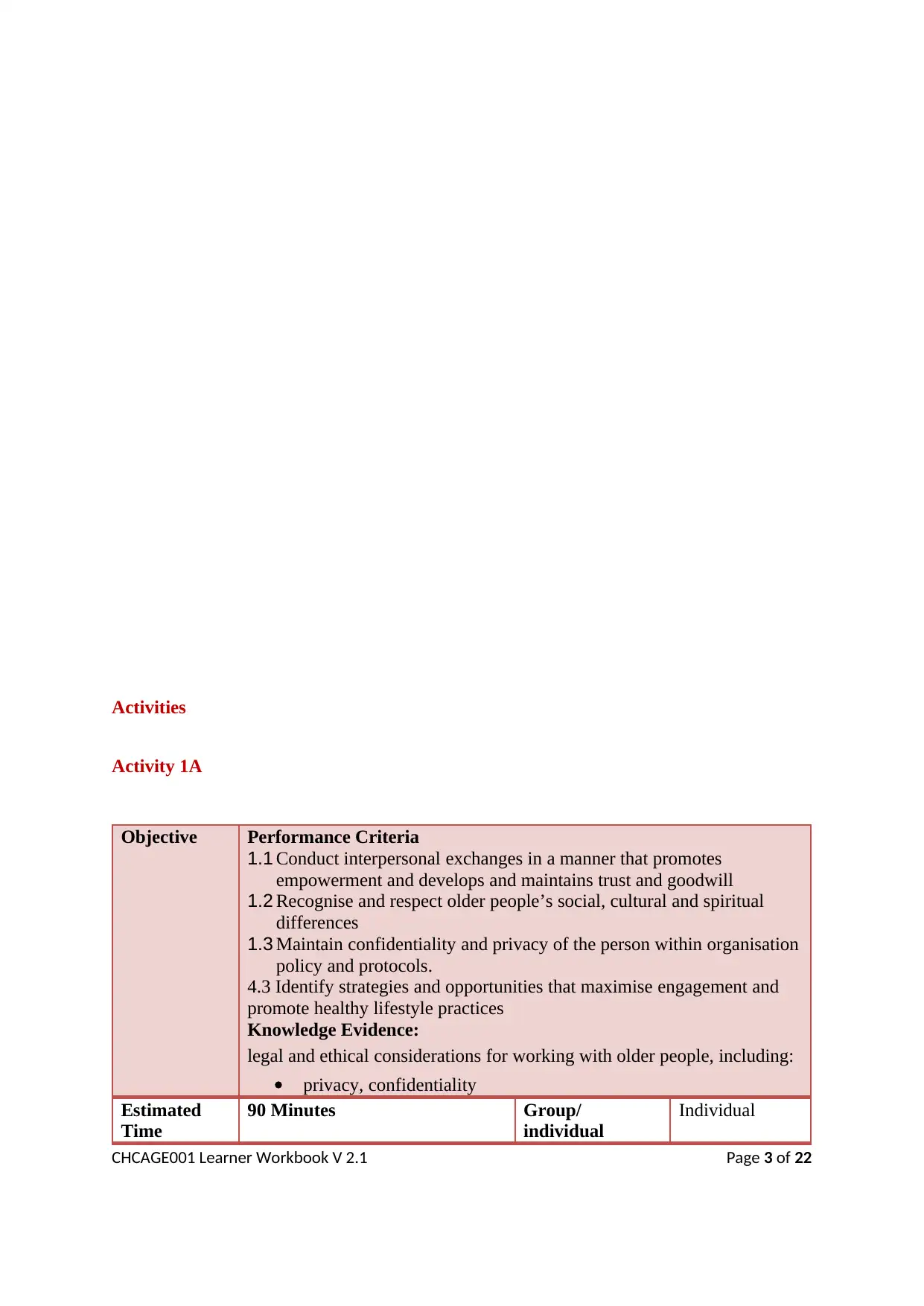
Activities
Activity 1A
Objective Performance Criteria
1.1 Conduct interpersonal exchanges in a manner that promotes
empowerment and develops and maintains trust and goodwill
1.2 Recognise and respect older people’s social, cultural and spiritual
differences
1.3 Maintain confidentiality and privacy of the person within organisation
policy and protocols.
4.3 Identify strategies and opportunities that maximise engagement and
promote healthy lifestyle practices
Knowledge Evidence:
legal and ethical considerations for working with older people, including:
privacy, confidentiality
Estimated
Time
90 Minutes Group/
individual
Individual
CHCAGE001 Learner Workbook V 2.1 Page 3 of 22
Activity 1A
Objective Performance Criteria
1.1 Conduct interpersonal exchanges in a manner that promotes
empowerment and develops and maintains trust and goodwill
1.2 Recognise and respect older people’s social, cultural and spiritual
differences
1.3 Maintain confidentiality and privacy of the person within organisation
policy and protocols.
4.3 Identify strategies and opportunities that maximise engagement and
promote healthy lifestyle practices
Knowledge Evidence:
legal and ethical considerations for working with older people, including:
privacy, confidentiality
Estimated
Time
90 Minutes Group/
individual
Individual
CHCAGE001 Learner Workbook V 2.1 Page 3 of 22
⊘ This is a preview!⊘
Do you want full access?
Subscribe today to unlock all pages.

Trusted by 1+ million students worldwide
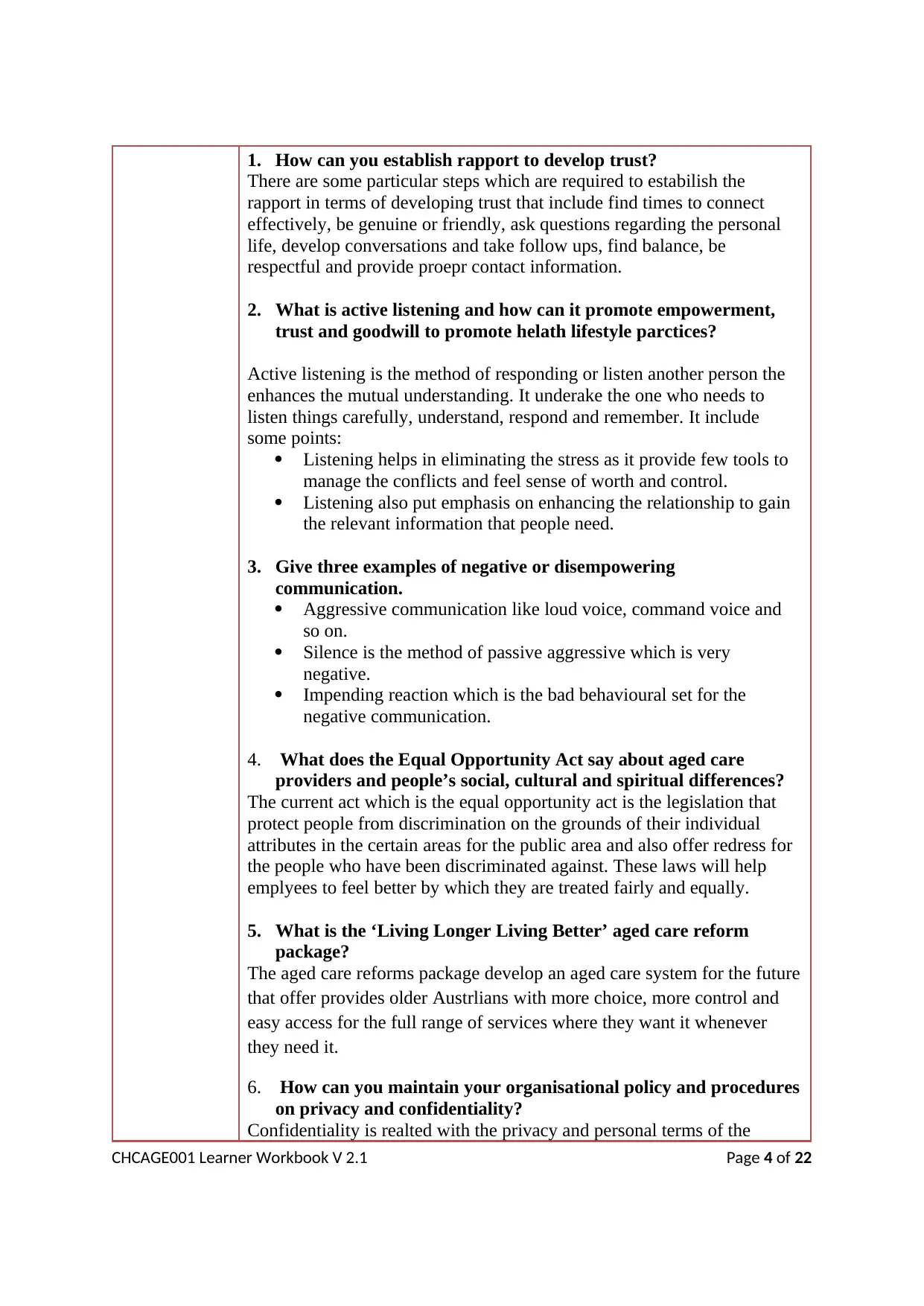
1. How can you establish rapport to develop trust?
There are some particular steps which are required to estabilish the
rapport in terms of developing trust that include find times to connect
effectively, be genuine or friendly, ask questions regarding the personal
life, develop conversations and take follow ups, find balance, be
respectful and provide proepr contact information.
2. What is active listening and how can it promote empowerment,
trust and goodwill to promote helath lifestyle parctices?
Active listening is the method of responding or listen another person the
enhances the mutual understanding. It underake the one who needs to
listen things carefully, understand, respond and remember. It include
some points:
Listening helps in eliminating the stress as it provide few tools to
manage the conflicts and feel sense of worth and control.
Listening also put emphasis on enhancing the relationship to gain
the relevant information that people need.
3. Give three examples of negative or disempowering
communication.
Aggressive communication like loud voice, command voice and
so on.
Silence is the method of passive aggressive which is very
negative.
Impending reaction which is the bad behavioural set for the
negative communication.
4. What does the Equal Opportunity Act say about aged care
providers and people’s social, cultural and spiritual differences?
The current act which is the equal opportunity act is the legislation that
protect people from discrimination on the grounds of their individual
attributes in the certain areas for the public area and also offer redress for
the people who have been discriminated against. These laws will help
emplyees to feel better by which they are treated fairly and equally.
5. What is the ‘Living Longer Living Better’ aged care reform
package?
The aged care reforms package develop an aged care system for the future
that offer provides older Austrlians with more choice, more control and
easy access for the full range of services where they want it whenever
they need it.
6. How can you maintain your organisational policy and procedures
on privacy and confidentiality?
Confidentiality is realted with the privacy and personal terms of the
CHCAGE001 Learner Workbook V 2.1 Page 4 of 22
There are some particular steps which are required to estabilish the
rapport in terms of developing trust that include find times to connect
effectively, be genuine or friendly, ask questions regarding the personal
life, develop conversations and take follow ups, find balance, be
respectful and provide proepr contact information.
2. What is active listening and how can it promote empowerment,
trust and goodwill to promote helath lifestyle parctices?
Active listening is the method of responding or listen another person the
enhances the mutual understanding. It underake the one who needs to
listen things carefully, understand, respond and remember. It include
some points:
Listening helps in eliminating the stress as it provide few tools to
manage the conflicts and feel sense of worth and control.
Listening also put emphasis on enhancing the relationship to gain
the relevant information that people need.
3. Give three examples of negative or disempowering
communication.
Aggressive communication like loud voice, command voice and
so on.
Silence is the method of passive aggressive which is very
negative.
Impending reaction which is the bad behavioural set for the
negative communication.
4. What does the Equal Opportunity Act say about aged care
providers and people’s social, cultural and spiritual differences?
The current act which is the equal opportunity act is the legislation that
protect people from discrimination on the grounds of their individual
attributes in the certain areas for the public area and also offer redress for
the people who have been discriminated against. These laws will help
emplyees to feel better by which they are treated fairly and equally.
5. What is the ‘Living Longer Living Better’ aged care reform
package?
The aged care reforms package develop an aged care system for the future
that offer provides older Austrlians with more choice, more control and
easy access for the full range of services where they want it whenever
they need it.
6. How can you maintain your organisational policy and procedures
on privacy and confidentiality?
Confidentiality is realted with the privacy and personal terms of the
CHCAGE001 Learner Workbook V 2.1 Page 4 of 22
Paraphrase This Document
Need a fresh take? Get an instant paraphrase of this document with our AI Paraphraser
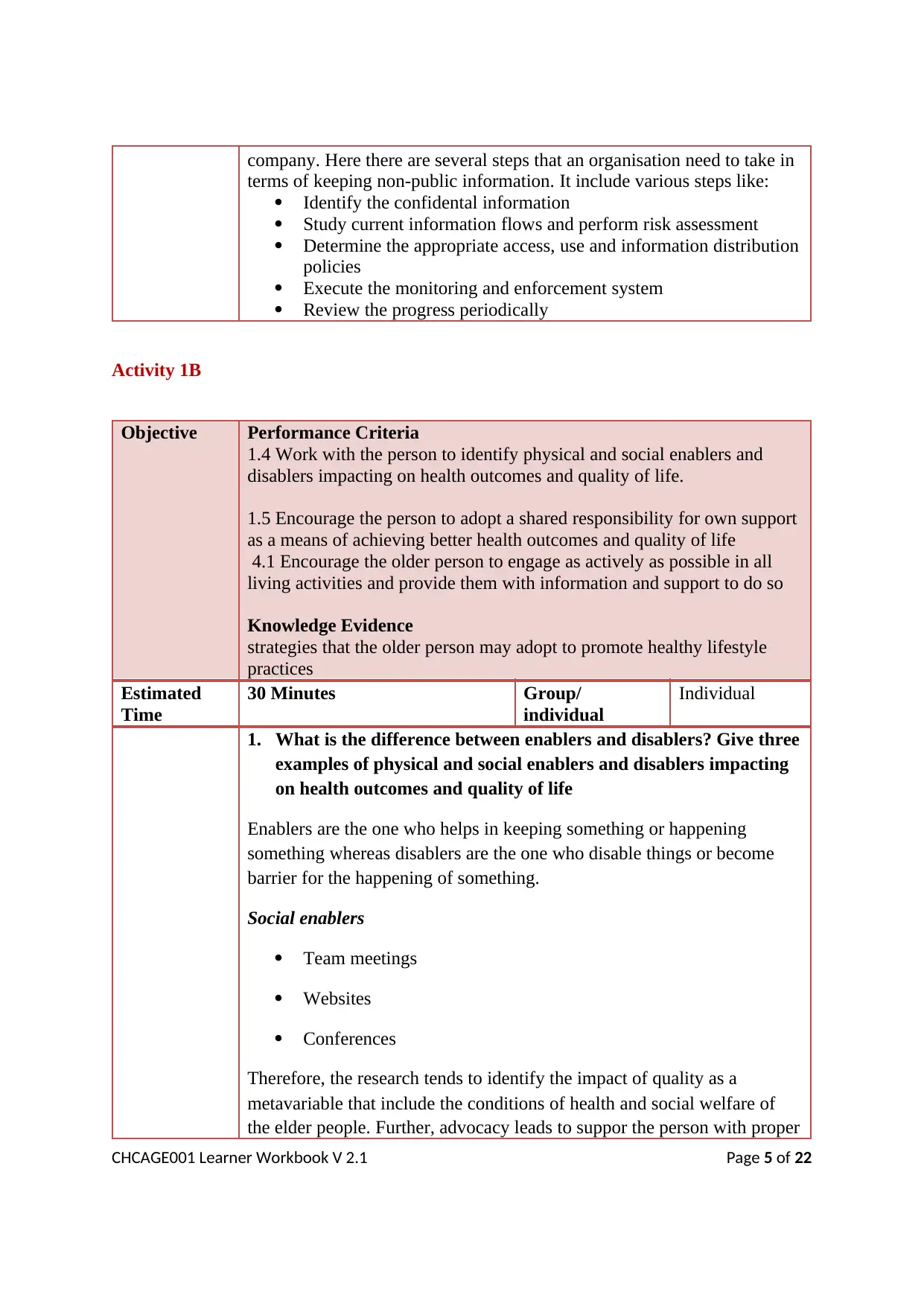
company. Here there are several steps that an organisation need to take in
terms of keeping non-public information. It include various steps like:
Identify the confidental information
Study current information flows and perform risk assessment
Determine the appropriate access, use and information distribution
policies
Execute the monitoring and enforcement system
Review the progress periodically
Activity 1B
Objective Performance Criteria
1.4 Work with the person to identify physical and social enablers and
disablers impacting on health outcomes and quality of life.
1.5 Encourage the person to adopt a shared responsibility for own support
as a means of achieving better health outcomes and quality of life
4.1 Encourage the older person to engage as actively as possible in all
living activities and provide them with information and support to do so
Knowledge Evidence
strategies that the older person may adopt to promote healthy lifestyle
practices
Estimated
Time
30 Minutes Group/
individual
Individual
1. What is the difference between enablers and disablers? Give three
examples of physical and social enablers and disablers impacting
on health outcomes and quality of life
Enablers are the one who helps in keeping something or happening
something whereas disablers are the one who disable things or become
barrier for the happening of something.
Social enablers
Team meetings
Websites
Conferences
Therefore, the research tends to identify the impact of quality as a
metavariable that include the conditions of health and social welfare of
the elder people. Further, advocacy leads to suppor the person with proper
CHCAGE001 Learner Workbook V 2.1 Page 5 of 22
terms of keeping non-public information. It include various steps like:
Identify the confidental information
Study current information flows and perform risk assessment
Determine the appropriate access, use and information distribution
policies
Execute the monitoring and enforcement system
Review the progress periodically
Activity 1B
Objective Performance Criteria
1.4 Work with the person to identify physical and social enablers and
disablers impacting on health outcomes and quality of life.
1.5 Encourage the person to adopt a shared responsibility for own support
as a means of achieving better health outcomes and quality of life
4.1 Encourage the older person to engage as actively as possible in all
living activities and provide them with information and support to do so
Knowledge Evidence
strategies that the older person may adopt to promote healthy lifestyle
practices
Estimated
Time
30 Minutes Group/
individual
Individual
1. What is the difference between enablers and disablers? Give three
examples of physical and social enablers and disablers impacting
on health outcomes and quality of life
Enablers are the one who helps in keeping something or happening
something whereas disablers are the one who disable things or become
barrier for the happening of something.
Social enablers
Team meetings
Websites
Conferences
Therefore, the research tends to identify the impact of quality as a
metavariable that include the conditions of health and social welfare of
the elder people. Further, advocacy leads to suppor the person with proper
CHCAGE001 Learner Workbook V 2.1 Page 5 of 22
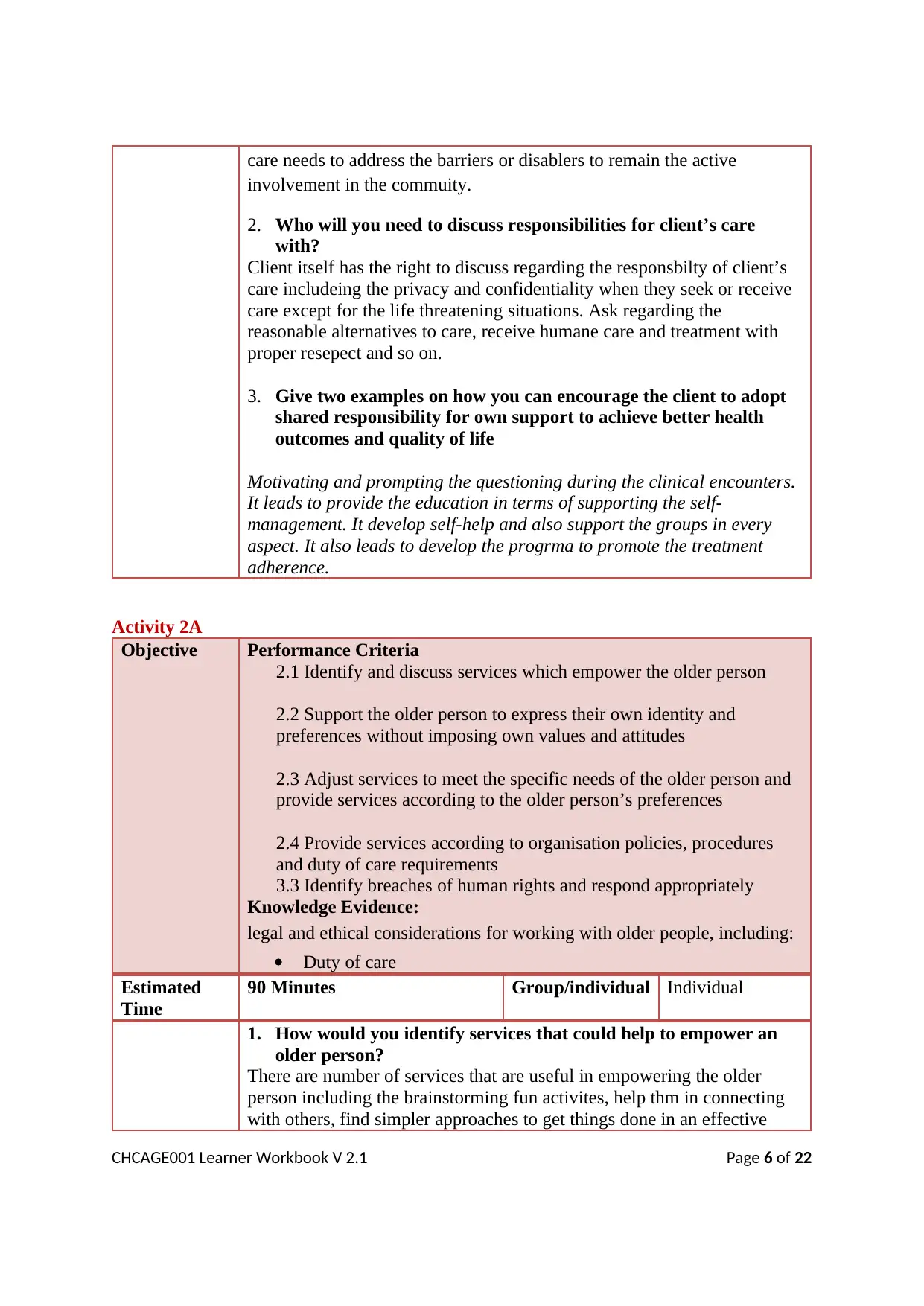
care needs to address the barriers or disablers to remain the active
involvement in the commuity.
2. Who will you need to discuss responsibilities for client’s care
with?
Client itself has the right to discuss regarding the responsbilty of client’s
care includeing the privacy and confidentiality when they seek or receive
care except for the life threatening situations. Ask regarding the
reasonable alternatives to care, receive humane care and treatment with
proper resepect and so on.
3. Give two examples on how you can encourage the client to adopt
shared responsibility for own support to achieve better health
outcomes and quality of life
Motivating and prompting the questioning during the clinical encounters.
It leads to provide the education in terms of supporting the self-
management. It develop self-help and also support the groups in every
aspect. It also leads to develop the progrma to promote the treatment
adherence.
Activity 2A
Objective Performance Criteria
2.1 Identify and discuss services which empower the older person
2.2 Support the older person to express their own identity and
preferences without imposing own values and attitudes
2.3 Adjust services to meet the specific needs of the older person and
provide services according to the older person’s preferences
2.4 Provide services according to organisation policies, procedures
and duty of care requirements
3.3 Identify breaches of human rights and respond appropriately
Knowledge Evidence:
legal and ethical considerations for working with older people, including:
Duty of care
Estimated
Time
90 Minutes Group/individual Individual
1. How would you identify services that could help to empower an
older person?
There are number of services that are useful in empowering the older
person including the brainstorming fun activites, help thm in connecting
with others, find simpler approaches to get things done in an effective
CHCAGE001 Learner Workbook V 2.1 Page 6 of 22
involvement in the commuity.
2. Who will you need to discuss responsibilities for client’s care
with?
Client itself has the right to discuss regarding the responsbilty of client’s
care includeing the privacy and confidentiality when they seek or receive
care except for the life threatening situations. Ask regarding the
reasonable alternatives to care, receive humane care and treatment with
proper resepect and so on.
3. Give two examples on how you can encourage the client to adopt
shared responsibility for own support to achieve better health
outcomes and quality of life
Motivating and prompting the questioning during the clinical encounters.
It leads to provide the education in terms of supporting the self-
management. It develop self-help and also support the groups in every
aspect. It also leads to develop the progrma to promote the treatment
adherence.
Activity 2A
Objective Performance Criteria
2.1 Identify and discuss services which empower the older person
2.2 Support the older person to express their own identity and
preferences without imposing own values and attitudes
2.3 Adjust services to meet the specific needs of the older person and
provide services according to the older person’s preferences
2.4 Provide services according to organisation policies, procedures
and duty of care requirements
3.3 Identify breaches of human rights and respond appropriately
Knowledge Evidence:
legal and ethical considerations for working with older people, including:
Duty of care
Estimated
Time
90 Minutes Group/individual Individual
1. How would you identify services that could help to empower an
older person?
There are number of services that are useful in empowering the older
person including the brainstorming fun activites, help thm in connecting
with others, find simpler approaches to get things done in an effective
CHCAGE001 Learner Workbook V 2.1 Page 6 of 22
⊘ This is a preview!⊘
Do you want full access?
Subscribe today to unlock all pages.

Trusted by 1+ million students worldwide
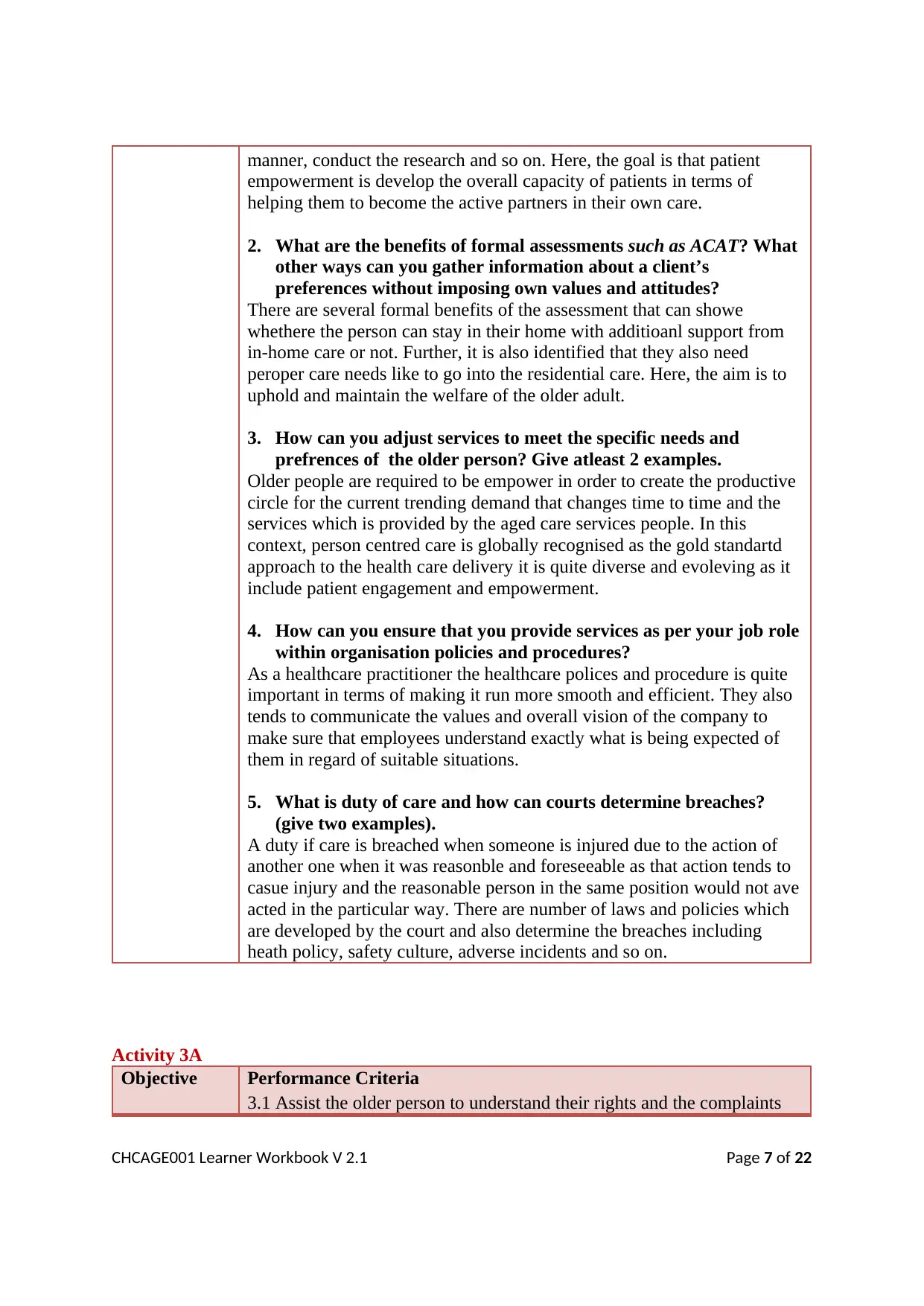
manner, conduct the research and so on. Here, the goal is that patient
empowerment is develop the overall capacity of patients in terms of
helping them to become the active partners in their own care.
2. What are the benefits of formal assessments such as ACAT? What
other ways can you gather information about a client’s
preferences without imposing own values and attitudes?
There are several formal benefits of the assessment that can showe
whethere the person can stay in their home with additioanl support from
in-home care or not. Further, it is also identified that they also need
peroper care needs like to go into the residential care. Here, the aim is to
uphold and maintain the welfare of the older adult.
3. How can you adjust services to meet the specific needs and
prefrences of the older person? Give atleast 2 examples.
Older people are required to be empower in order to create the productive
circle for the current trending demand that changes time to time and the
services which is provided by the aged care services people. In this
context, person centred care is globally recognised as the gold standartd
approach to the health care delivery it is quite diverse and evoleving as it
include patient engagement and empowerment.
4. How can you ensure that you provide services as per your job role
within organisation policies and procedures?
As a healthcare practitioner the healthcare polices and procedure is quite
important in terms of making it run more smooth and efficient. They also
tends to communicate the values and overall vision of the company to
make sure that employees understand exactly what is being expected of
them in regard of suitable situations.
5. What is duty of care and how can courts determine breaches?
(give two examples).
A duty if care is breached when someone is injured due to the action of
another one when it was reasonble and foreseeable as that action tends to
casue injury and the reasonable person in the same position would not ave
acted in the particular way. There are number of laws and policies which
are developed by the court and also determine the breaches including
heath policy, safety culture, adverse incidents and so on.
Activity 3A
Objective Performance Criteria
3.1 Assist the older person to understand their rights and the complaints
CHCAGE001 Learner Workbook V 2.1 Page 7 of 22
empowerment is develop the overall capacity of patients in terms of
helping them to become the active partners in their own care.
2. What are the benefits of formal assessments such as ACAT? What
other ways can you gather information about a client’s
preferences without imposing own values and attitudes?
There are several formal benefits of the assessment that can showe
whethere the person can stay in their home with additioanl support from
in-home care or not. Further, it is also identified that they also need
peroper care needs like to go into the residential care. Here, the aim is to
uphold and maintain the welfare of the older adult.
3. How can you adjust services to meet the specific needs and
prefrences of the older person? Give atleast 2 examples.
Older people are required to be empower in order to create the productive
circle for the current trending demand that changes time to time and the
services which is provided by the aged care services people. In this
context, person centred care is globally recognised as the gold standartd
approach to the health care delivery it is quite diverse and evoleving as it
include patient engagement and empowerment.
4. How can you ensure that you provide services as per your job role
within organisation policies and procedures?
As a healthcare practitioner the healthcare polices and procedure is quite
important in terms of making it run more smooth and efficient. They also
tends to communicate the values and overall vision of the company to
make sure that employees understand exactly what is being expected of
them in regard of suitable situations.
5. What is duty of care and how can courts determine breaches?
(give two examples).
A duty if care is breached when someone is injured due to the action of
another one when it was reasonble and foreseeable as that action tends to
casue injury and the reasonable person in the same position would not ave
acted in the particular way. There are number of laws and policies which
are developed by the court and also determine the breaches including
heath policy, safety culture, adverse incidents and so on.
Activity 3A
Objective Performance Criteria
3.1 Assist the older person to understand their rights and the complaints
CHCAGE001 Learner Workbook V 2.1 Page 7 of 22
Paraphrase This Document
Need a fresh take? Get an instant paraphrase of this document with our AI Paraphraser
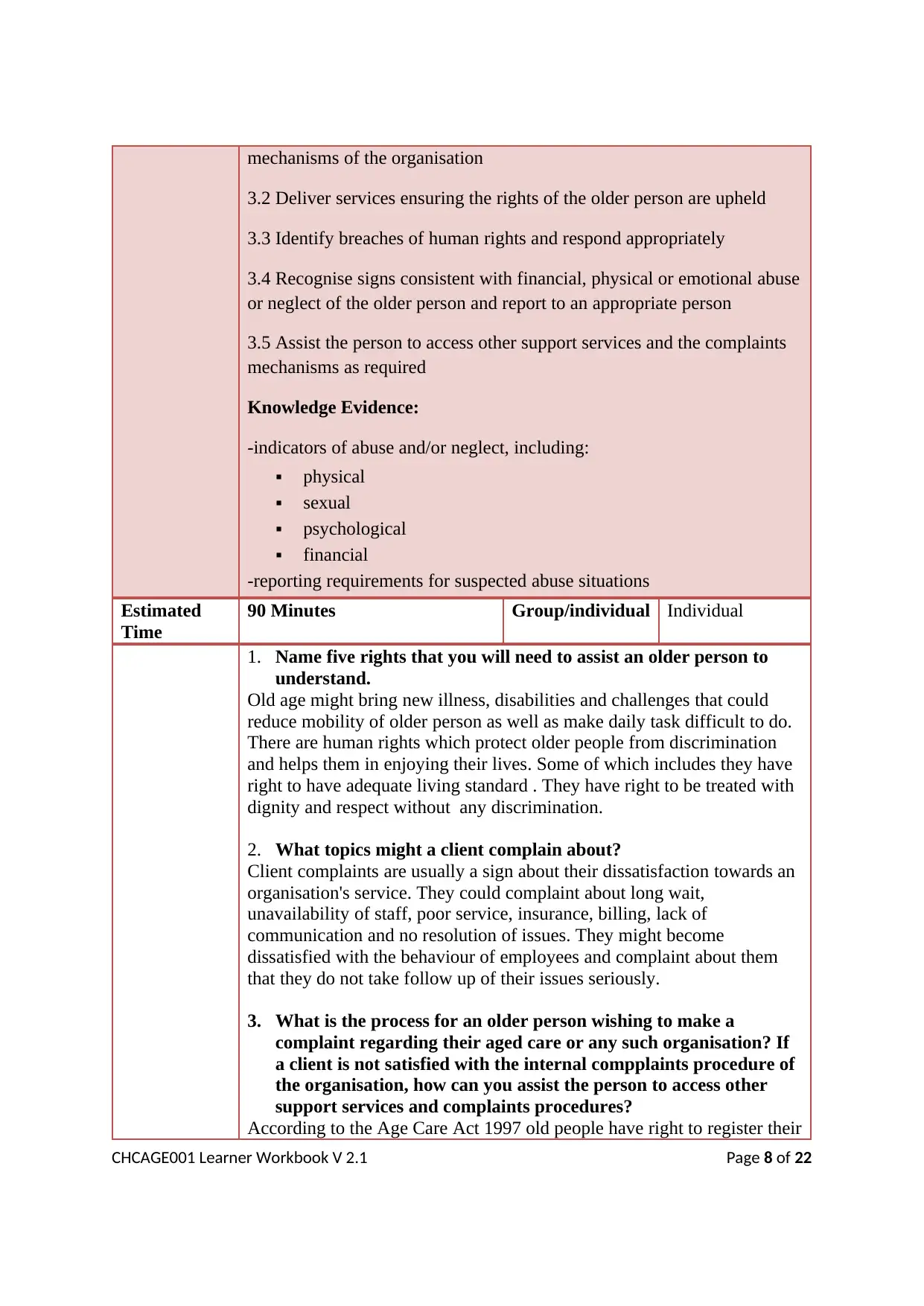
mechanisms of the organisation
3.2 Deliver services ensuring the rights of the older person are upheld
3.3 Identify breaches of human rights and respond appropriately
3.4 Recognise signs consistent with financial, physical or emotional abuse
or neglect of the older person and report to an appropriate person
3.5 Assist the person to access other support services and the complaints
mechanisms as required
Knowledge Evidence:
-indicators of abuse and/or neglect, including:
physical
sexual
psychological
financial
-reporting requirements for suspected abuse situations
Estimated
Time
90 Minutes Group/individual Individual
1. Name five rights that you will need to assist an older person to
understand.
Old age might bring new illness, disabilities and challenges that could
reduce mobility of older person as well as make daily task difficult to do.
There are human rights which protect older people from discrimination
and helps them in enjoying their lives. Some of which includes they have
right to have adequate living standard . They have right to be treated with
dignity and respect without any discrimination.
2. What topics might a client complain about?
Client complaints are usually a sign about their dissatisfaction towards an
organisation's service. They could complaint about long wait,
unavailability of staff, poor service, insurance, billing, lack of
communication and no resolution of issues. They might become
dissatisfied with the behaviour of employees and complaint about them
that they do not take follow up of their issues seriously.
3. What is the process for an older person wishing to make a
complaint regarding their aged care or any such organisation? If
a client is not satisfied with the internal compplaints procedure of
the organisation, how can you assist the person to access other
support services and complaints procedures?
According to the Age Care Act 1997 old people have right to register their
CHCAGE001 Learner Workbook V 2.1 Page 8 of 22
3.2 Deliver services ensuring the rights of the older person are upheld
3.3 Identify breaches of human rights and respond appropriately
3.4 Recognise signs consistent with financial, physical or emotional abuse
or neglect of the older person and report to an appropriate person
3.5 Assist the person to access other support services and the complaints
mechanisms as required
Knowledge Evidence:
-indicators of abuse and/or neglect, including:
physical
sexual
psychological
financial
-reporting requirements for suspected abuse situations
Estimated
Time
90 Minutes Group/individual Individual
1. Name five rights that you will need to assist an older person to
understand.
Old age might bring new illness, disabilities and challenges that could
reduce mobility of older person as well as make daily task difficult to do.
There are human rights which protect older people from discrimination
and helps them in enjoying their lives. Some of which includes they have
right to have adequate living standard . They have right to be treated with
dignity and respect without any discrimination.
2. What topics might a client complain about?
Client complaints are usually a sign about their dissatisfaction towards an
organisation's service. They could complaint about long wait,
unavailability of staff, poor service, insurance, billing, lack of
communication and no resolution of issues. They might become
dissatisfied with the behaviour of employees and complaint about them
that they do not take follow up of their issues seriously.
3. What is the process for an older person wishing to make a
complaint regarding their aged care or any such organisation? If
a client is not satisfied with the internal compplaints procedure of
the organisation, how can you assist the person to access other
support services and complaints procedures?
According to the Age Care Act 1997 old people have right to register their
CHCAGE001 Learner Workbook V 2.1 Page 8 of 22
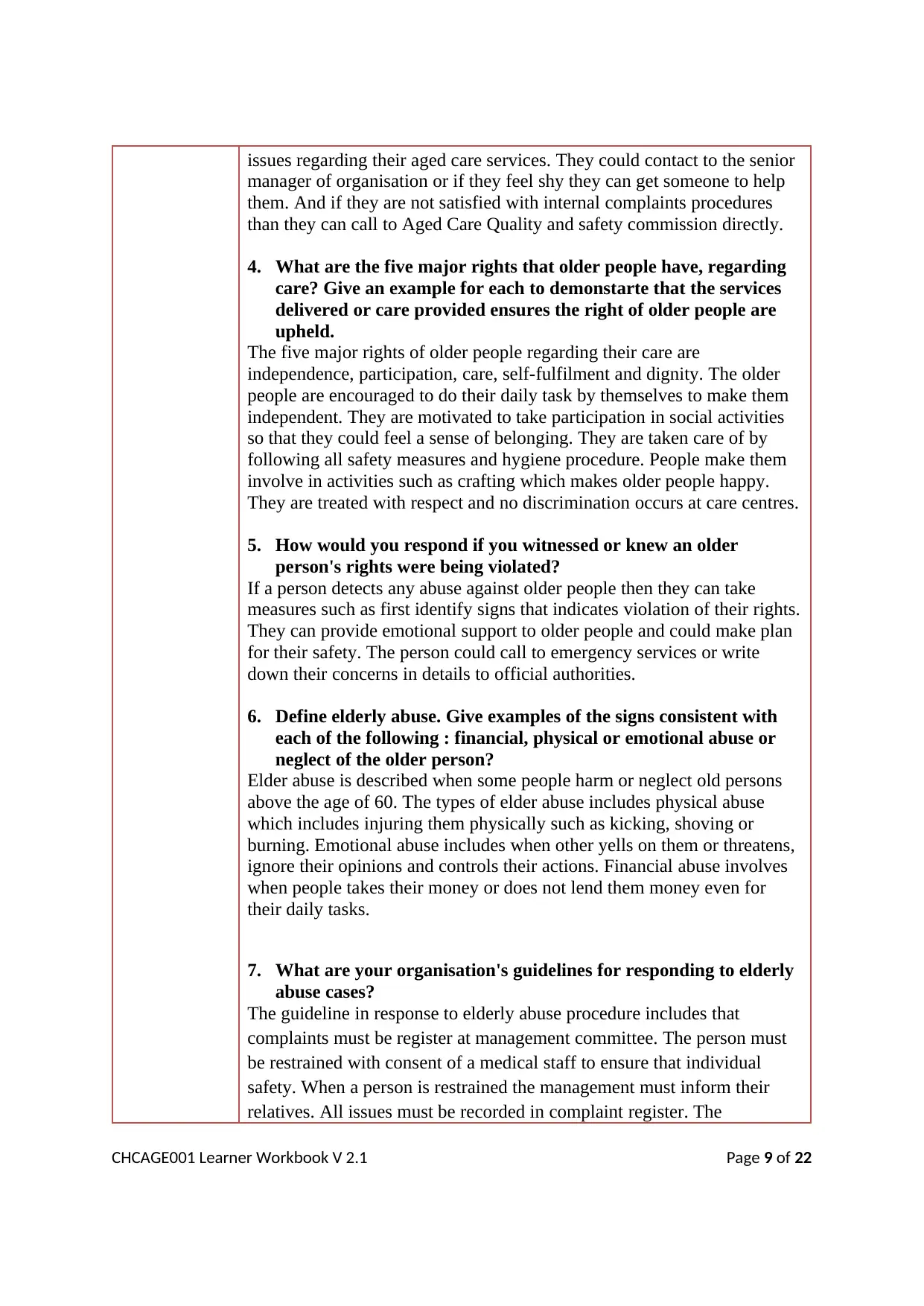
issues regarding their aged care services. They could contact to the senior
manager of organisation or if they feel shy they can get someone to help
them. And if they are not satisfied with internal complaints procedures
than they can call to Aged Care Quality and safety commission directly.
4. What are the five major rights that older people have, regarding
care? Give an example for each to demonstarte that the services
delivered or care provided ensures the right of older people are
upheld.
The five major rights of older people regarding their care are
independence, participation, care, self-fulfilment and dignity. The older
people are encouraged to do their daily task by themselves to make them
independent. They are motivated to take participation in social activities
so that they could feel a sense of belonging. They are taken care of by
following all safety measures and hygiene procedure. People make them
involve in activities such as crafting which makes older people happy.
They are treated with respect and no discrimination occurs at care centres.
5. How would you respond if you witnessed or knew an older
person's rights were being violated?
If a person detects any abuse against older people then they can take
measures such as first identify signs that indicates violation of their rights.
They can provide emotional support to older people and could make plan
for their safety. The person could call to emergency services or write
down their concerns in details to official authorities.
6. Define elderly abuse. Give examples of the signs consistent with
each of the following : financial, physical or emotional abuse or
neglect of the older person?
Elder abuse is described when some people harm or neglect old persons
above the age of 60. The types of elder abuse includes physical abuse
which includes injuring them physically such as kicking, shoving or
burning. Emotional abuse includes when other yells on them or threatens,
ignore their opinions and controls their actions. Financial abuse involves
when people takes their money or does not lend them money even for
their daily tasks.
7. What are your organisation's guidelines for responding to elderly
abuse cases?
The guideline in response to elderly abuse procedure includes that
complaints must be register at management committee. The person must
be restrained with consent of a medical staff to ensure that individual
safety. When a person is restrained the management must inform their
relatives. All issues must be recorded in complaint register. The
CHCAGE001 Learner Workbook V 2.1 Page 9 of 22
manager of organisation or if they feel shy they can get someone to help
them. And if they are not satisfied with internal complaints procedures
than they can call to Aged Care Quality and safety commission directly.
4. What are the five major rights that older people have, regarding
care? Give an example for each to demonstarte that the services
delivered or care provided ensures the right of older people are
upheld.
The five major rights of older people regarding their care are
independence, participation, care, self-fulfilment and dignity. The older
people are encouraged to do their daily task by themselves to make them
independent. They are motivated to take participation in social activities
so that they could feel a sense of belonging. They are taken care of by
following all safety measures and hygiene procedure. People make them
involve in activities such as crafting which makes older people happy.
They are treated with respect and no discrimination occurs at care centres.
5. How would you respond if you witnessed or knew an older
person's rights were being violated?
If a person detects any abuse against older people then they can take
measures such as first identify signs that indicates violation of their rights.
They can provide emotional support to older people and could make plan
for their safety. The person could call to emergency services or write
down their concerns in details to official authorities.
6. Define elderly abuse. Give examples of the signs consistent with
each of the following : financial, physical or emotional abuse or
neglect of the older person?
Elder abuse is described when some people harm or neglect old persons
above the age of 60. The types of elder abuse includes physical abuse
which includes injuring them physically such as kicking, shoving or
burning. Emotional abuse includes when other yells on them or threatens,
ignore their opinions and controls their actions. Financial abuse involves
when people takes their money or does not lend them money even for
their daily tasks.
7. What are your organisation's guidelines for responding to elderly
abuse cases?
The guideline in response to elderly abuse procedure includes that
complaints must be register at management committee. The person must
be restrained with consent of a medical staff to ensure that individual
safety. When a person is restrained the management must inform their
relatives. All issues must be recorded in complaint register. The
CHCAGE001 Learner Workbook V 2.1 Page 9 of 22
⊘ This is a preview!⊘
Do you want full access?
Subscribe today to unlock all pages.

Trusted by 1+ million students worldwide
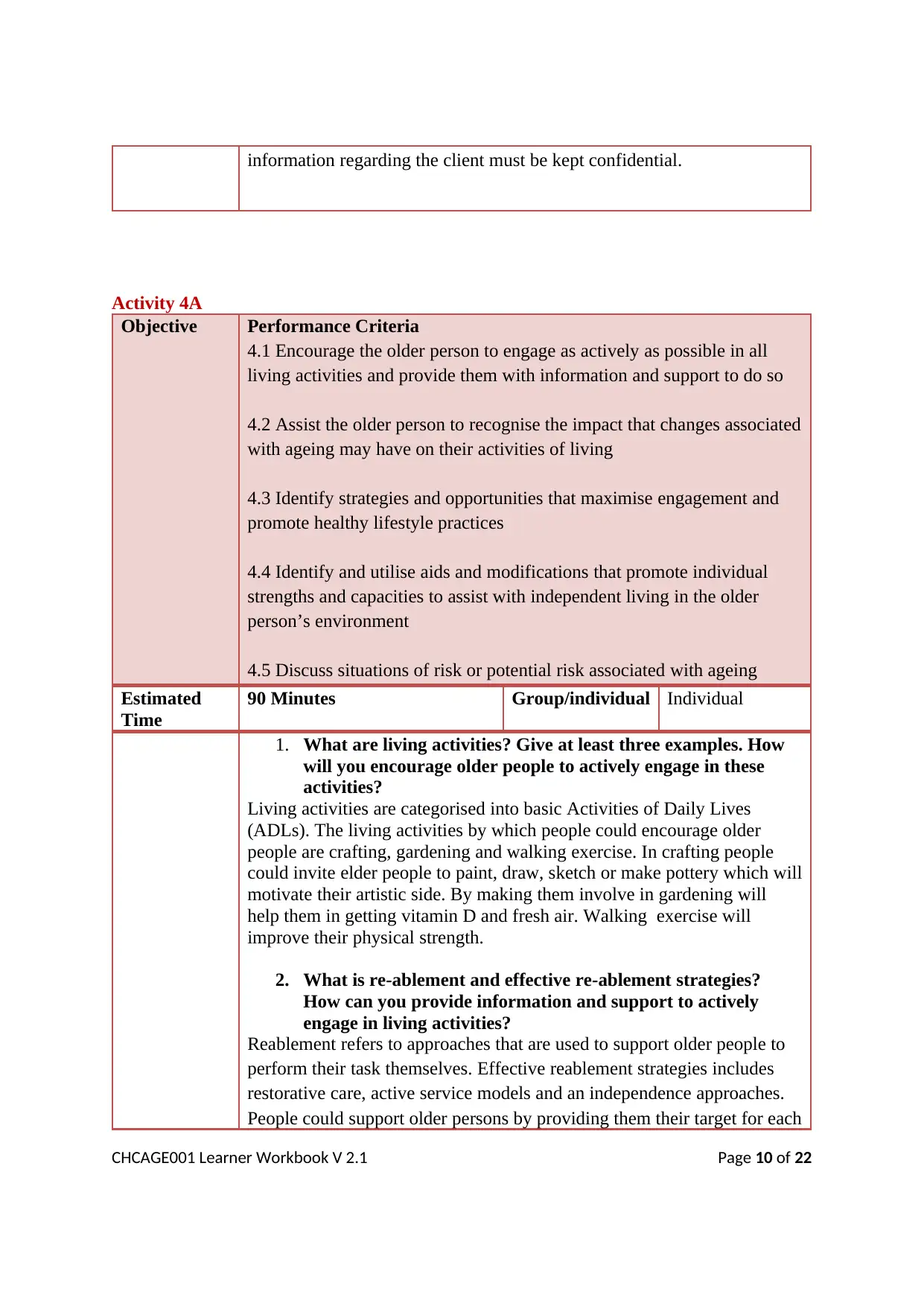
information regarding the client must be kept confidential.
Activity 4A
Objective Performance Criteria
4.1 Encourage the older person to engage as actively as possible in all
living activities and provide them with information and support to do so
4.2 Assist the older person to recognise the impact that changes associated
with ageing may have on their activities of living
4.3 Identify strategies and opportunities that maximise engagement and
promote healthy lifestyle practices
4.4 Identify and utilise aids and modifications that promote individual
strengths and capacities to assist with independent living in the older
person’s environment
4.5 Discuss situations of risk or potential risk associated with ageing
Estimated
Time
90 Minutes Group/individual Individual
1. What are living activities? Give at least three examples. How
will you encourage older people to actively engage in these
activities?
Living activities are categorised into basic Activities of Daily Lives
(ADLs). The living activities by which people could encourage older
people are crafting, gardening and walking exercise. In crafting people
could invite elder people to paint, draw, sketch or make pottery which will
motivate their artistic side. By making them involve in gardening will
help them in getting vitamin D and fresh air. Walking exercise will
improve their physical strength.
2. What is re-ablement and effective re-ablement strategies?
How can you provide information and support to actively
engage in living activities?
Reablement refers to approaches that are used to support older people to
perform their task themselves. Effective reablement strategies includes
restorative care, active service models and an independence approaches.
People could support older persons by providing them their target for each
CHCAGE001 Learner Workbook V 2.1 Page 10 of 22
Activity 4A
Objective Performance Criteria
4.1 Encourage the older person to engage as actively as possible in all
living activities and provide them with information and support to do so
4.2 Assist the older person to recognise the impact that changes associated
with ageing may have on their activities of living
4.3 Identify strategies and opportunities that maximise engagement and
promote healthy lifestyle practices
4.4 Identify and utilise aids and modifications that promote individual
strengths and capacities to assist with independent living in the older
person’s environment
4.5 Discuss situations of risk or potential risk associated with ageing
Estimated
Time
90 Minutes Group/individual Individual
1. What are living activities? Give at least three examples. How
will you encourage older people to actively engage in these
activities?
Living activities are categorised into basic Activities of Daily Lives
(ADLs). The living activities by which people could encourage older
people are crafting, gardening and walking exercise. In crafting people
could invite elder people to paint, draw, sketch or make pottery which will
motivate their artistic side. By making them involve in gardening will
help them in getting vitamin D and fresh air. Walking exercise will
improve their physical strength.
2. What is re-ablement and effective re-ablement strategies?
How can you provide information and support to actively
engage in living activities?
Reablement refers to approaches that are used to support older people to
perform their task themselves. Effective reablement strategies includes
restorative care, active service models and an independence approaches.
People could support older persons by providing them their target for each
CHCAGE001 Learner Workbook V 2.1 Page 10 of 22
Paraphrase This Document
Need a fresh take? Get an instant paraphrase of this document with our AI Paraphraser
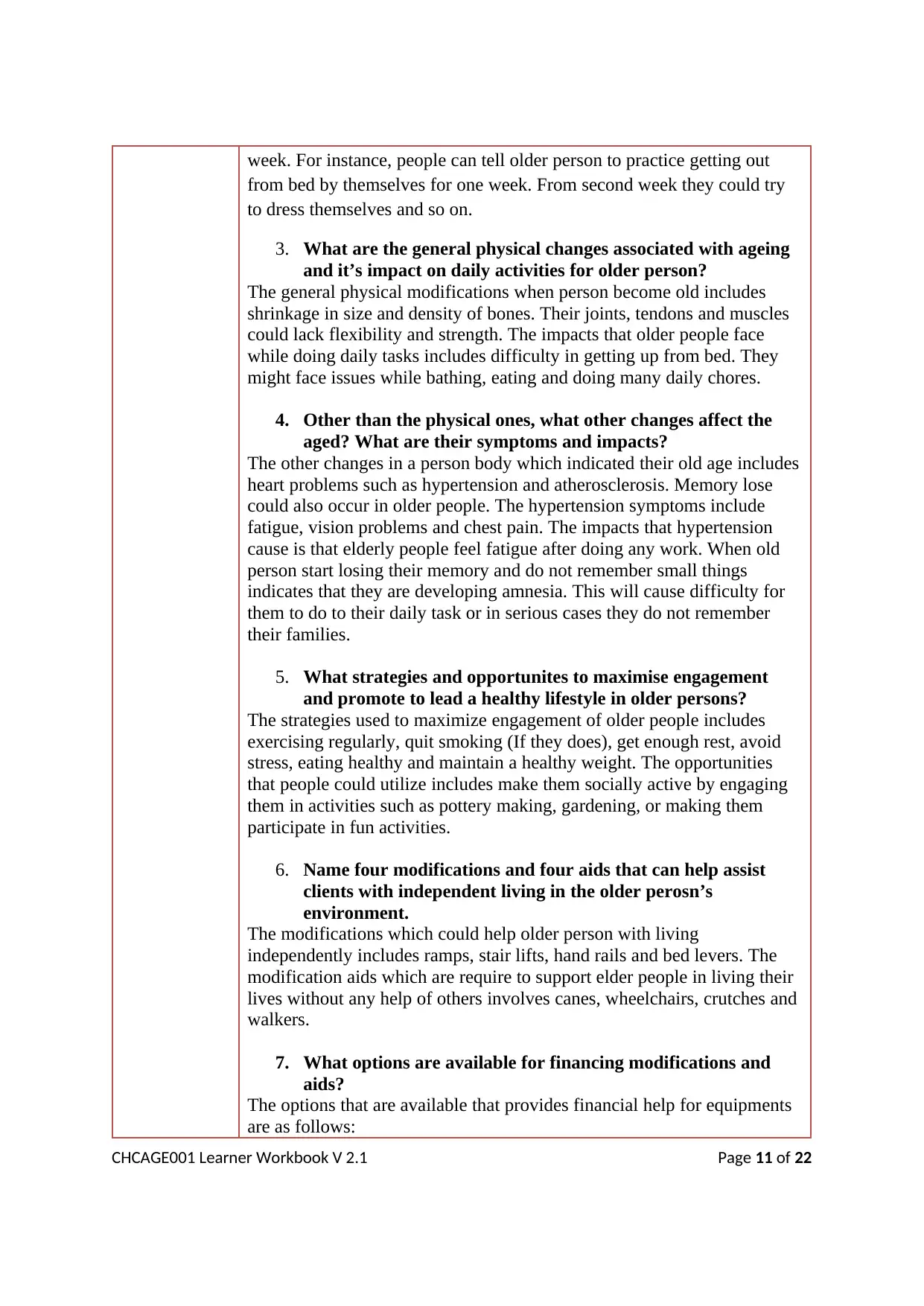
week. For instance, people can tell older person to practice getting out
from bed by themselves for one week. From second week they could try
to dress themselves and so on.
3. What are the general physical changes associated with ageing
and it’s impact on daily activities for older person?
The general physical modifications when person become old includes
shrinkage in size and density of bones. Their joints, tendons and muscles
could lack flexibility and strength. The impacts that older people face
while doing daily tasks includes difficulty in getting up from bed. They
might face issues while bathing, eating and doing many daily chores.
4. Other than the physical ones, what other changes affect the
aged? What are their symptoms and impacts?
The other changes in a person body which indicated their old age includes
heart problems such as hypertension and atherosclerosis. Memory lose
could also occur in older people. The hypertension symptoms include
fatigue, vision problems and chest pain. The impacts that hypertension
cause is that elderly people feel fatigue after doing any work. When old
person start losing their memory and do not remember small things
indicates that they are developing amnesia. This will cause difficulty for
them to do to their daily task or in serious cases they do not remember
their families.
5. What strategies and opportunites to maximise engagement
and promote to lead a healthy lifestyle in older persons?
The strategies used to maximize engagement of older people includes
exercising regularly, quit smoking (If they does), get enough rest, avoid
stress, eating healthy and maintain a healthy weight. The opportunities
that people could utilize includes make them socially active by engaging
them in activities such as pottery making, gardening, or making them
participate in fun activities.
6. Name four modifications and four aids that can help assist
clients with independent living in the older perosn’s
environment.
The modifications which could help older person with living
independently includes ramps, stair lifts, hand rails and bed levers. The
modification aids which are require to support elder people in living their
lives without any help of others involves canes, wheelchairs, crutches and
walkers.
7. What options are available for financing modifications and
aids?
The options that are available that provides financial help for equipments
are as follows:
CHCAGE001 Learner Workbook V 2.1 Page 11 of 22
from bed by themselves for one week. From second week they could try
to dress themselves and so on.
3. What are the general physical changes associated with ageing
and it’s impact on daily activities for older person?
The general physical modifications when person become old includes
shrinkage in size and density of bones. Their joints, tendons and muscles
could lack flexibility and strength. The impacts that older people face
while doing daily tasks includes difficulty in getting up from bed. They
might face issues while bathing, eating and doing many daily chores.
4. Other than the physical ones, what other changes affect the
aged? What are their symptoms and impacts?
The other changes in a person body which indicated their old age includes
heart problems such as hypertension and atherosclerosis. Memory lose
could also occur in older people. The hypertension symptoms include
fatigue, vision problems and chest pain. The impacts that hypertension
cause is that elderly people feel fatigue after doing any work. When old
person start losing their memory and do not remember small things
indicates that they are developing amnesia. This will cause difficulty for
them to do to their daily task or in serious cases they do not remember
their families.
5. What strategies and opportunites to maximise engagement
and promote to lead a healthy lifestyle in older persons?
The strategies used to maximize engagement of older people includes
exercising regularly, quit smoking (If they does), get enough rest, avoid
stress, eating healthy and maintain a healthy weight. The opportunities
that people could utilize includes make them socially active by engaging
them in activities such as pottery making, gardening, or making them
participate in fun activities.
6. Name four modifications and four aids that can help assist
clients with independent living in the older perosn’s
environment.
The modifications which could help older person with living
independently includes ramps, stair lifts, hand rails and bed levers. The
modification aids which are require to support elder people in living their
lives without any help of others involves canes, wheelchairs, crutches and
walkers.
7. What options are available for financing modifications and
aids?
The options that are available that provides financial help for equipments
are as follows:
CHCAGE001 Learner Workbook V 2.1 Page 11 of 22
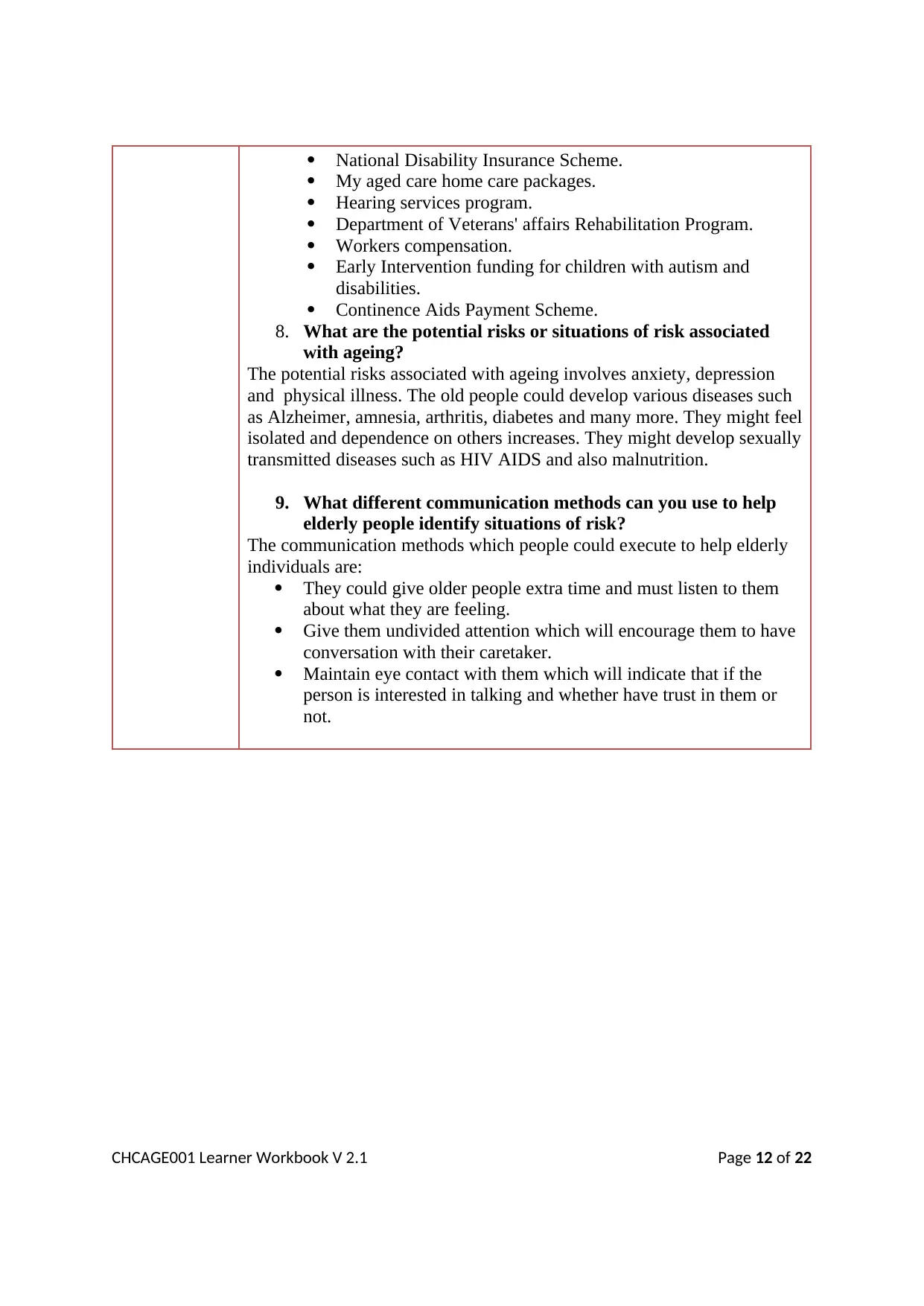
National Disability Insurance Scheme.
My aged care home care packages.
Hearing services program.
Department of Veterans' affairs Rehabilitation Program.
Workers compensation.
Early Intervention funding for children with autism and
disabilities.
Continence Aids Payment Scheme.
8. What are the potential risks or situations of risk associated
with ageing?
The potential risks associated with ageing involves anxiety, depression
and physical illness. The old people could develop various diseases such
as Alzheimer, amnesia, arthritis, diabetes and many more. They might feel
isolated and dependence on others increases. They might develop sexually
transmitted diseases such as HIV AIDS and also malnutrition.
9. What different communication methods can you use to help
elderly people identify situations of risk?
The communication methods which people could execute to help elderly
individuals are:
They could give older people extra time and must listen to them
about what they are feeling.
Give them undivided attention which will encourage them to have
conversation with their caretaker.
Maintain eye contact with them which will indicate that if the
person is interested in talking and whether have trust in them or
not.
CHCAGE001 Learner Workbook V 2.1 Page 12 of 22
My aged care home care packages.
Hearing services program.
Department of Veterans' affairs Rehabilitation Program.
Workers compensation.
Early Intervention funding for children with autism and
disabilities.
Continence Aids Payment Scheme.
8. What are the potential risks or situations of risk associated
with ageing?
The potential risks associated with ageing involves anxiety, depression
and physical illness. The old people could develop various diseases such
as Alzheimer, amnesia, arthritis, diabetes and many more. They might feel
isolated and dependence on others increases. They might develop sexually
transmitted diseases such as HIV AIDS and also malnutrition.
9. What different communication methods can you use to help
elderly people identify situations of risk?
The communication methods which people could execute to help elderly
individuals are:
They could give older people extra time and must listen to them
about what they are feeling.
Give them undivided attention which will encourage them to have
conversation with their caretaker.
Maintain eye contact with them which will indicate that if the
person is interested in talking and whether have trust in them or
not.
CHCAGE001 Learner Workbook V 2.1 Page 12 of 22
⊘ This is a preview!⊘
Do you want full access?
Subscribe today to unlock all pages.

Trusted by 1+ million students worldwide
1 out of 22
Related Documents
Your All-in-One AI-Powered Toolkit for Academic Success.
+13062052269
info@desklib.com
Available 24*7 on WhatsApp / Email
![[object Object]](/_next/static/media/star-bottom.7253800d.svg)
Unlock your academic potential
Copyright © 2020–2025 A2Z Services. All Rights Reserved. Developed and managed by ZUCOL.





